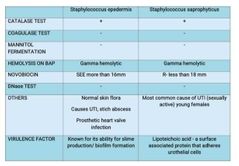![]()
![]()
![]()
Use LEFT and RIGHT arrow keys to navigate between flashcards;
Use UP and DOWN arrow keys to flip the card;
H to show hint;
A reads text to speech;
31 Cards in this Set
- Front
- Back
|
STAPHYLOCOCCI |
• Gram positive cocci in grape like clusters • Non-motile • Catalase Test (+) – presumptive test to differentiate Staphylococci and Micrococcus from Streptococci • Principle: H2O2 is converted to water and oxygen by the presence of enzyme Catalase • Reagent: 3% H2O2 - can be directly add to the culture media or in the slide; (+) result: vigorous bubbling • Colonies from Blood test agar plates can cause False (+) reaction in this test . |
|
|
As to Pigment formation / Growth on Leoffer’s Serum Slant (LSS) |
°Staphylococcus aureus – golden yellow °Staphylococcus citreus – lemon yellow °Staphylococcus albus – white |
|
|
Staphylococcus aureus' GROWTH/COLONY MORPHOLOGY: |
• Normal flora of anterior nares and nasopharynx • PCR will enable detection from nasal swab • Uniform turbidity on broth • On plates, they produced smooth circular and opaque colonies with oil-like or butyrous appearance • Jet black colonies on tellurite agar |
|
|
TEST FOR IDENTIFICATION (S. aureus) |
• Catalase (+) • Coagulase (+) • Mannitol Fermentation (+) • DNase Test (+) • VP and Nitrate (+) |
|
|
HEMOLYSIS ON BAP: |
Beta – hemolytic |
|
|
SUSCEPTIBILITY TEST: |
Sensitive to Lyostaphin and Novobiocin Resistant to Polymyxin |
|
|
VIRULENCE FACTORS: |
• Catalase is produced by S. aureus BUT it has never been a virulence factor! It has nothing to do with the ability of the organism to produce a disease . |
|
|
ENZYMES: |
Lipase – initiates skin infection Hyaluronidase – spreading factor; it enhances the invasion into the tissues Beta lactamase/ penicillinase – makes the S. aureus resistant to penicillin Staphylokinase – promotes fibrinolysis (dissolution of clot) Coagulase – it causes the bacterial cells to agglutinate in the plasma; it also converts fibrinogen to fibrin. Beta-hemolysin – responsible for the β-hemolytic property of S. aureus Protein A – prevents phagocytosis |
|
|
TOXINS: |
• Enterotoxin A and B – food poisoning • Enterotoxin F / TSST – causes the Toxic Shock Syndrome |
|
|
Exfoliation |
– epidemolytic toxin that causes desquamation (or exfoliation) of the skin in Scalded Skin Syndrome aka Ritter’s disease . |
|
|
– incomplete/partial hemolysis on BAP causing the greening of the agar • Streptococcus pneumoniae, Viridans Streptococci – S. mitis and S. mutans |
Alpha hemolytic Streptococci |
|
|
– complete hemolysis showing clear zones around the colony • Streptococcus pyogenes and Streptococcus agalactiae |
Beta hemolytic Streptococci |
|
|
– unable to cause hemolysis on BAP Ex: E. faecalis, E. faecium, S. bovis |
Gamma hemolytic Streptococci |
|
|
– when a colony is surrounded by an inner alpha and outer beta zone. This may occur due to prolonged refrigeration |
Alpha prime |
|
|
– based on the hemolytic pattern of the organisms |
Smith and Brown Classification |
|
|
– based on the physiologic needs of the organism |
Academic or Bergey’s Classification |
|
|
= (-) 10 and 45°C but (+) in 37°C i.e. S. pyogenes |
Pyogenic |
|
|
= (+) 45°C but (-) in 10°C i.e. S. mitis, S. mutans. S. sanguis, S. salivarius, S. constellatus S. intermedius |
Viridans |
|
|
= (+) 10 and 45°C i.e. E. faecalis |
Enterococci |
|
|
= (+) 10°C but (-) in 45°C i.e. S. lactis and S. cremoris |
Lactic group |
|
|
– based on the extraction of C Carbohydrate from Streptococcal cell wall |
Lancefield Classification |
|
|
All Streptococci are placed under Lancefield EXCEPT: |
Viridans and S. pneumoniae |
|
|
Other Gram (+), Catalase (-) organisms isolated from Clinical Specimens (that can cause infection in immunocompromised): |
• Pediococcus • Lactococcus • Aerococcus • Rothia • Leuconostoc |
|
|
– broth: (Histopathology) use as an adhesive in exfoliative cytology; low virulence potential |
Leuconostoc |
|
|
- Aka Thiol-requiring Streptococci / Pyridoxal Streptococci / Satelliting Streptococci
- These are S. adjacens and S. defectives
- These are viridans needing Vitamin B-6 in their media
- When mixed with S. aureus they satellite around the colonies of S. aureus |
Abiotrophia |
|
|
– known to cause liver, spleen and brain abscesses |
Milleri Streptococci Complex
Colonies: “caramel” / “butter scotch” odor Species: S. constellatus, S. intermedius, S. anginosus |
|
|
Hemolytic Pattern: |
• Alpha – Viridans and S. pneumoniae • Beta – Group A, B, C and some Group D (Lancefield) • Gamma – mostly Group D |
|
|
– targets WBC, causing its destruction; associate with MRSA (Methicillin-resistant S. aureus) infection - It can be Community-acquired / Hospital-acquired.
The Hospital acquiredMRSA is difficult to treat due to its resistant to almost all antibiotics except Glycopeptides (vancomycin) |
PVL/ Panton Valentine Leucocidin |
|
|
TOXIC MEDIATED DISEASES: |
• Food poisoning • Toxic Shock Syndrome • Scalded Skin Syndrome |
|
|
– skin infection of epidermidis, involving epithelial cells |
Bullous impetigo |
|
|
Coagulase- Negative Staphylococci (CONS) |

|

